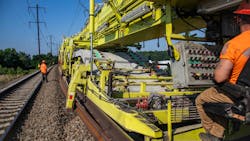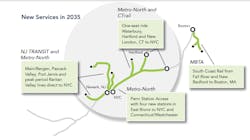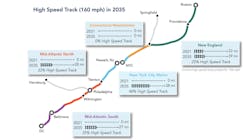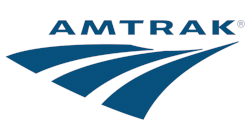CONNECT NEC 2035 lays out 15-year map to deliver better rail service on the Northeast Corridor
The Northeast Corridor Commission released a 15-year vision for the Northeast Corridor (NEC) that will require billions in investment but is designed to deliver modern and resilient railroad infrastructure with more frequent service, connections to new markets and faster travel times.
CONNECT NEC 2035 (C35) includes 150 projects and capital renewal efforts along the corridor and was developed with the federal government, state governments in the Northeast, eight commuter railroads and Amtrak. C35 furthers foundational efforts laid with the 2017 NEC FUTURE plan, which was developed the by Federal Railroad Administration.
“Improving the NEC rail system is a vital multi-state effort,” said Deputy Administrator of the Federal Railroad Administration and NEC Commission co-chair Amit Bose. “C35 is a sequenced plan and a mobilizing force that not only puts people back at work renewing the NEC, but also supports new travel patterns as our economy returns to full strength.”
While the COVID-19 pandemic impacted transit and passenger rail ridership in the region, stakeholders say the build out of the C35 plan will deliver an estimated 60 million trips annually. The plan’s benefits fall into four main categories: Improve mobility and connections; create economic opportunity; combat climate change; and support desirable cities and communities.
C35 promises to riders travel times between New York City and Washington, D.C., and New York City and Boston that are approximately 30 minutes faster. Commuter railroads will provide double their level of service and Amtrak will see a 33-percent increase in intercity service.
“The corridor supports more than 800,000 daily passenger trips between the greater Washington, D.C., and Boston regions,” said President and CEO of New Jersey Transit and NEC Commission Co-chair Kevin Corbett. “It is imperative that together we seize this once-in-a-generation opportunity to replace aging assets, add rail capacity, improve performance and enhance the customer experience along the entire corridor through the advancement of the vital and ambitious C35 plan.”
The 150 projects included in C35 are grouped into 59 special projects and 119 capital renew projects. The C35 investments will replace:
- More than 9 million linear feet of rail.
- More than 1.35 million crossties.
- 900 turnouts.
- More than 17,500 catenary poles.
- 235 under grade bridges.
- 205 interlockings.
The vision comes with a $117-billion program cost, of which a $100-billion funding gap exists. Stakeholders say C35 will require a strong federal-state funding partnership and they recognize delivery of individual projects will not result in the same outcomes that multiple projects can deliver. They recommend making funding for the program predictable, as well as funding the plan rather than individual projects.
“C35 represents a big step towards the high-quality rail network our nation and this vital region deserve. The investments in infrastructure laid out in this plan will lead to more modern, reliable and faster trains, expanded service and a better customer experience – that will benefit customers, economies and local communities along the entire Northeast Corridor and beyond,” said Amtrak President Stephen Gardner. “Amtrak stands ready to join forces with our partners and help deliver the C35 plan.”
Stakeholders explain CONNECT NEC is an “ongoing, iterative process” and the Northeast Corridor Commission intends to update the plan in two years, as well as refine the plan as new projects, funding sources or other resources become available.
The full plan, along with fact sheets on each of the C35 territories is available at the Northeast Corridor Commission's C35 website.

Mischa Wanek-Libman | Group Editorial Director
Mischa Wanek-Libman is director of communications with Transdev North America. She has more than 20 years of experience working in the transportation industry covering construction projects, engineering challenges, transit and rail operations and best practices.
Wanek-Libman has held top editorial positions at freight rail and public transportation business-to-business publications including as editor-in-chief and editorial director of Mass Transit from 2018-2024. She has been recognized for editorial excellence through her individual work, as well as for collaborative content.
She is an active member of the American Public Transportation Association's Marketing and Communications Committee and served 14 years as a Board Observer on the National Railroad Construction and Maintenance Association (NRC) Board of Directors.
She is a graduate of Drake University in Des Moines, Iowa, where she earned a Bachelor of Arts degree in Journalism and Mass Communication.





